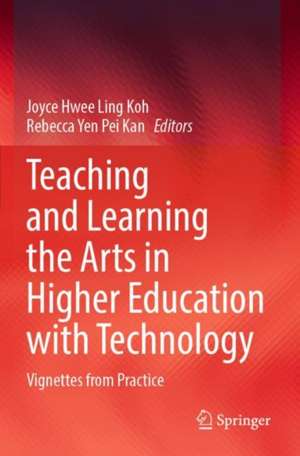Teaching and Learning the Arts in Higher Education with Technology: Vignettes from Practice
Editat de Joyce Hwee Ling Koh, Rebecca Yen Pei Kanen Limba Engleză Paperback – 3 dec 2022
| Toate formatele și edițiile | Preț | Express |
|---|---|---|
| Paperback (1) | 777.50 lei 43-57 zile | |
| Springer Nature Singapore – 3 dec 2022 | 777.50 lei 43-57 zile | |
| Hardback (1) | 783.50 lei 43-57 zile | |
| Springer Nature Singapore – 2 dec 2021 | 783.50 lei 43-57 zile |
Preț: 777.50 lei
Preț vechi: 948.18 lei
-18% Nou
Puncte Express: 1166
Preț estimativ în valută:
148.77€ • 155.75$ • 123.10£
148.77€ • 155.75$ • 123.10£
Carte tipărită la comandă
Livrare economică 07-21 aprilie
Preluare comenzi: 021 569.72.76
Specificații
ISBN-13: 9789811649059
ISBN-10: 9811649057
Pagini: 209
Ilustrații: VIII, 209 p. 56 illus., 39 illus. in color.
Dimensiuni: 155 x 235 mm
Greutate: 0.31 kg
Ediția:1st ed. 2021
Editura: Springer Nature Singapore
Colecția Springer
Locul publicării:Singapore, Singapore
ISBN-10: 9811649057
Pagini: 209
Ilustrații: VIII, 209 p. 56 illus., 39 illus. in color.
Dimensiuni: 155 x 235 mm
Greutate: 0.31 kg
Ediția:1st ed. 2021
Editura: Springer Nature Singapore
Colecția Springer
Locul publicării:Singapore, Singapore
Cuprins
Chapter 1. Educating the Artist with Technology?.- Part I:Arts in Practice.- Chapter 2. Articulating Theatre Students’ Conceptions of Movement in Body-Time-Space through Video-based Peer Critique.- Chapter 3. Supporting Mental Practice with Digital Resources in Gamelan Performance – A Personal Narrative.- Chapter 4. Supporting Fashion Design Students’ Metacognition during Patternmaking with Canvas™ Tools.- Part 2: Conceptual Understanding.- Chapter 5. Understanding Dance Production: Blending Learning from Online to Classroom to the Stage.- Chapter 6. Culture, Media, and Self-Identity – Supporting Students’ Expression of Thinking with the OPINE Framework.- Part 3: Products in Design.- Chapter 7. Developing Design and Media Students’ Capacity for Design Rationalisation with Electronic Portfolios.- Chapter 8.- Creative Inquiry in Graphic Design: Studio Habits in an Integrated Arts Project.- Part 4: Institutional Contexts.- Chapter 9. A Professional Development Workshop for Supporting Artist Educators’ Creation of Technological Pedagogical Content Knowledge.- Chapter 10. Creating Institutional Technological Pedagogical Content Knowledge – A Case Study through the Eyes of an Educational Technology Support Unit.- Chapter 11. Educating the Artist with Technology: COVID-19 and beyond.
Notă biografică
Joyce Hwee Ling Koh is an Associate Professor at the Higher Education Development Centre of the University of Otago, New Zealand. She is widely published in the area of educational technology and Design Thinking for education; and is currently a Senior Associate Editor of the Asia Pacific Educational Researcher.
Rebecca Kan is Vice-Dean (Pedagogy & Research) at Nanyang Academy of Fine Arts in Singapore. She leads research on artistic practices and scholarship in teaching and learning, as well as strategic, conceptual and administrative planning that build the capacity of people, and a passion for the arts. She is a recipient of the Tan Poey Quee Doctor in Education Scholarship for her EdD research at the National Institute of Education, Nanyang Technological University, Singapore.
Rebecca Kan is Vice-Dean (Pedagogy & Research) at Nanyang Academy of Fine Arts in Singapore. She leads research on artistic practices and scholarship in teaching and learning, as well as strategic, conceptual and administrative planning that build the capacity of people, and a passion for the arts. She is a recipient of the Tan Poey Quee Doctor in Education Scholarship for her EdD research at the National Institute of Education, Nanyang Technological University, Singapore.
Textul de pe ultima copertă
This book is an inquiry about the possibilities of using technology to support the education of artists within higher education contexts. Even though technology-enhanced learning and teaching may seem incongruent with the long-established studio-based cultures of making and performing, it is increasingly becoming a pivotal point to connect artistes to potential audience and markets. Amidst the COVID-19 pandemic, technology is also the crucial linchpin for educational continuity of student artists. This book explores how technology could enhance the education of artists and designers as they continue to create, make, and add value to life and society through their artistry. It draws upon the experiences of the Nanyang Academy of Fine Arts (NAFA), a pioneering arts institution in Singapore with over 80 years of institutional history. Through 9 vignettes, this book illustrates technology-enhanced pedagogical practices that have been implemented in different artistic learning spaces including classroom, studio, and stage as well as institutional support strategies. With a naturalistic stance, these chapters seek to illuminate realistic pictures of teaching and learning that are being uncovered by artist educators as they sought to integrate technology within teaching practices using available technologies and within the classes that they are teaching. It is hoped that this book will stimulate conversation among artist educators about possible pedagogical models, as well as inform higher arts institutions about the contextual strategies needed to support the creation of technology-enhanced pedagogical practices.
Caracteristici
Profiles technology-enhanced pedagogies and implementation outcomes in different contexts in higher arts education
Written by artist educators for artist educators
Discusses institutional support strategies for technology-enhanced pedagogies
Written by artist educators for artist educators
Discusses institutional support strategies for technology-enhanced pedagogies
